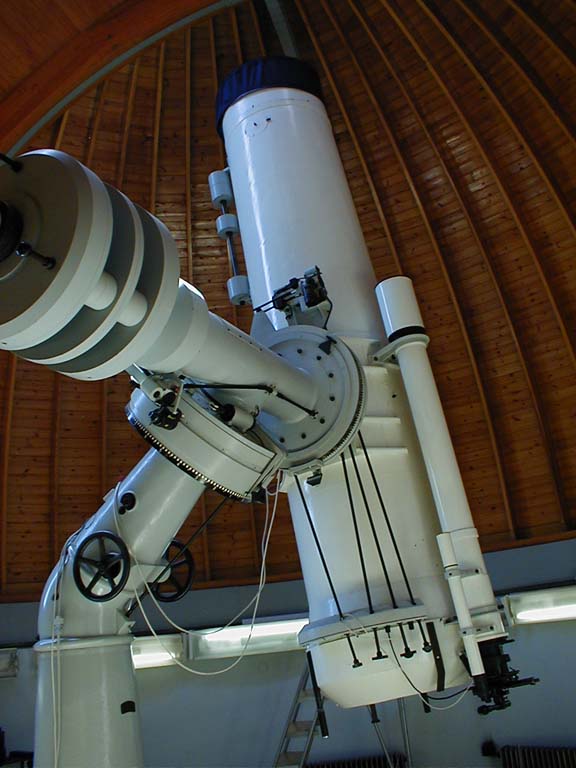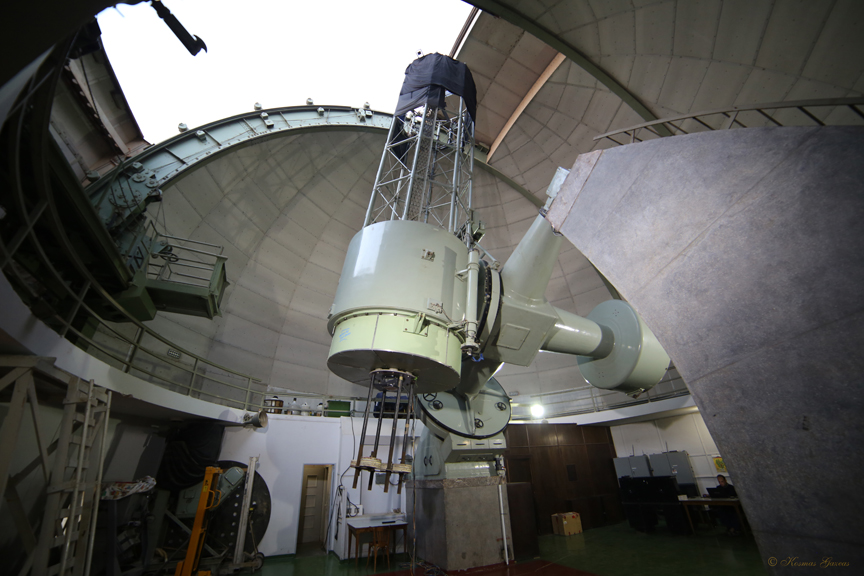Observations

The blazar observations within the project are obtained at the Rozhen National Astronomical Observatory (NAO, Bulgaria) using the 2-m Ritchey-Chrétien and 50/70 cm Schmidt telescopes and Kottamia Astronomical Observatory (KAO, Egypt) using 1.88-m telescope.
 Rozhen National Astronomical Observatory is located at the Rhodope mountain, a few kilometers away from the Rozhen pass. The latitude of the observatory is 41° 41′ 19.79″ N, the longitude is 24° 44′ 10.19″ E, and the altitude is 1750 meters above the sea level. The largest telescope at the observatory is the 2-m reflector manufactured by Carl Zeiss - Jena. The instrument is of Ritchey-Chrétien optical design, having a hyperbolic main mirror with hyperbolic secondaries to give Ritchey-Chrétien and Coudé foci. The main mirror has a focal ratio of ƒ/?, at the Ritchey-Chrétien focus the focal ratio is ƒ/8 (plate scale of 12.89 ″/mm), and at the Coudé focus the focal ratio is ƒ/36. The modes of the telescope operations are: direct mode (imaging at the Ritchey-Chrétien focus), FoReRo-2 mode (imaging, low-dispersion spectroscopy, imaging polarimetry, and spectropolarimetry using the two-channel focal reducer Rozhen, FoReRo-2, at the Ritchey-Chrétien focus; click here or here), ESpeRo mode (high-dispersion eshelle spectrograph Rozhen, ESpeRo, fiber-fed from the Ritchey-Chrétien focus; click here), and Coudé mode (classical high-dispersion Coudé spectrograph at the Coudé focus). The current CCD cameras used are the Peletier cooled, 2048×2048 Andor iKon-L CCDs with a pixel size of 13.5 μm. This pixel size results in a scale factor of 0.174 ″/px in the direct mode and 0.497 ″/px in the FoReRo-2 mode; the corresponding field-of-views are 5.9×5.9′ and 17.0×17.0′. In the FoReRo-2 mode the effective focal ratio becomes ƒ/2.8, the polarimetric setup uses either a Wollaston prism and a half-wave plate or a double Wollaston prism, and the spectroscopic setup uses a grism of 300 grooves/mm. The imaging can be done through Johnson-Cousins, Sloan, and narrow-band filters.
Rozhen National Astronomical Observatory is located at the Rhodope mountain, a few kilometers away from the Rozhen pass. The latitude of the observatory is 41° 41′ 19.79″ N, the longitude is 24° 44′ 10.19″ E, and the altitude is 1750 meters above the sea level. The largest telescope at the observatory is the 2-m reflector manufactured by Carl Zeiss - Jena. The instrument is of Ritchey-Chrétien optical design, having a hyperbolic main mirror with hyperbolic secondaries to give Ritchey-Chrétien and Coudé foci. The main mirror has a focal ratio of ƒ/?, at the Ritchey-Chrétien focus the focal ratio is ƒ/8 (plate scale of 12.89 ″/mm), and at the Coudé focus the focal ratio is ƒ/36. The modes of the telescope operations are: direct mode (imaging at the Ritchey-Chrétien focus), FoReRo-2 mode (imaging, low-dispersion spectroscopy, imaging polarimetry, and spectropolarimetry using the two-channel focal reducer Rozhen, FoReRo-2, at the Ritchey-Chrétien focus; click here or here), ESpeRo mode (high-dispersion eshelle spectrograph Rozhen, ESpeRo, fiber-fed from the Ritchey-Chrétien focus; click here), and Coudé mode (classical high-dispersion Coudé spectrograph at the Coudé focus). The current CCD cameras used are the Peletier cooled, 2048×2048 Andor iKon-L CCDs with a pixel size of 13.5 μm. This pixel size results in a scale factor of 0.174 ″/px in the direct mode and 0.497 ″/px in the FoReRo-2 mode; the corresponding field-of-views are 5.9×5.9′ and 17.0×17.0′. In the FoReRo-2 mode the effective focal ratio becomes ƒ/2.8, the polarimetric setup uses either a Wollaston prism and a half-wave plate or a double Wollaston prism, and the spectroscopic setup uses a grism of 300 grooves/mm. The imaging can be done through Johnson-Cousins, Sloan, and narrow-band filters.
 The Rozhen NAO Schmidt telescope, manufactured by Carl Zeiss - Jena, was originally located at the Potsdam Astrophysical Observatory (German Democratic Republic) and operated since 1952. At the initiative of prof. B. Kovachev and on the basis of a mutual agreement between the Bulgarian Academy of Sciences and the Academy of Sciences of the German Democratic Republic, the Schmidt telescope was repaired, according to the new latitude, and in May 1979 was transferred to the Rozhen NAO; the increased air and light pollution in the growing capital city made the scientific use of the telescope impossible in Potsdam. The Schmidt lens, made of BK 7 glass, has a diameter of 50 cm, and the main spherical mirror, made of Tempax glass − 70 cm. The focal length of the main mirror is 172 cm (focal ratio of ƒ/3.44), which results in a plate scale of 120 ″/mm. The size of the photographic plates used with a Piazzi-Smith corrector was 16×16 cm, which results in a field-of-view of 5.3×5.3°. The telescope also has a 50 cm objective prism, made of UBK 7 glass, with an angle of refraction 3.5° and an average dispersion of 820 Ang/mm in the Hγ−Hε region. The first observations with the Schmidt telescope at Rozhen NAO have been conducted in the summer of 1979, namely patrol observations of flare stars in Pleiades using the method of the equal multiple exposures; the latest photographic observations have been obtained in 1996. At the present time, the telescope is equiped with the FLI PL16803 model CCD camera. The CCD chip is KAF-16803 having maximum quantum efficiency of about 60% at 5500 Ang, dimension of 4096×4096 px, and a pixel size of 9 μm. The scale factor is 1.079 ″/px, and the field-of-view is 1.23×1.23°. The standard Johnson-Cousins photometric system is realized with an Astrodon set of filters.
The Rozhen NAO Schmidt telescope, manufactured by Carl Zeiss - Jena, was originally located at the Potsdam Astrophysical Observatory (German Democratic Republic) and operated since 1952. At the initiative of prof. B. Kovachev and on the basis of a mutual agreement between the Bulgarian Academy of Sciences and the Academy of Sciences of the German Democratic Republic, the Schmidt telescope was repaired, according to the new latitude, and in May 1979 was transferred to the Rozhen NAO; the increased air and light pollution in the growing capital city made the scientific use of the telescope impossible in Potsdam. The Schmidt lens, made of BK 7 glass, has a diameter of 50 cm, and the main spherical mirror, made of Tempax glass − 70 cm. The focal length of the main mirror is 172 cm (focal ratio of ƒ/3.44), which results in a plate scale of 120 ″/mm. The size of the photographic plates used with a Piazzi-Smith corrector was 16×16 cm, which results in a field-of-view of 5.3×5.3°. The telescope also has a 50 cm objective prism, made of UBK 7 glass, with an angle of refraction 3.5° and an average dispersion of 820 Ang/mm in the Hγ−Hε region. The first observations with the Schmidt telescope at Rozhen NAO have been conducted in the summer of 1979, namely patrol observations of flare stars in Pleiades using the method of the equal multiple exposures; the latest photographic observations have been obtained in 1996. At the present time, the telescope is equiped with the FLI PL16803 model CCD camera. The CCD chip is KAF-16803 having maximum quantum efficiency of about 60% at 5500 Ang, dimension of 4096×4096 px, and a pixel size of 9 μm. The scale factor is 1.079 ″/px, and the field-of-view is 1.23×1.23°. The standard Johnson-Cousins photometric system is realized with an Astrodon set of filters.
 Kottamia Astronomical Observatory is located at the Kottamia mountain. The latitude of the observatory is 29° 55′ 35.24″ N, the longitude is 31° 49′ 45.85″ E, and the altitude is 476 meters above the sea level. The largest telescope at the observatory is the 1.88-m reflector built by Grubb Parsons of Newcastle, U.K., and delivered to the observatory in 1963. The instrument is of classical optical design, having a parabolic main mirror with flat/hyperbolic secondaries to give Newtonian, Cassegrain, and Coudé foci. The main mirror has a focal ratio of ƒ/4.9, at the Cassegrain focus the focal ratio is ƒ/18 (plate scale of 6.1 ″/mm), and at the Coudé focus the focal ratio is ƒ/28.9. Currently, the main scientific apparatus used at the 1.88-m telescope is the Kottamia Faint Imaging Spectro-Polarimeter (KFISP), mounted at the Cassegrain focus; the effective focal ratio at the Cassegrain focus becomes ƒ/6.14. KFISP has various modes of operation: imaging, low-dispersion spectroscopy, imaging polarimetry, and spectropolarimetry. The light detector is a 2048×2048 pixels CCD camera with a pixel size of 13.5 μm. The scale factor at the Cassegrain focus is 0.24 ″/px, and the field-of-view is 8.2×8.2′. The camera is cooled by liquid Nitrogen.
Kottamia Astronomical Observatory is located at the Kottamia mountain. The latitude of the observatory is 29° 55′ 35.24″ N, the longitude is 31° 49′ 45.85″ E, and the altitude is 476 meters above the sea level. The largest telescope at the observatory is the 1.88-m reflector built by Grubb Parsons of Newcastle, U.K., and delivered to the observatory in 1963. The instrument is of classical optical design, having a parabolic main mirror with flat/hyperbolic secondaries to give Newtonian, Cassegrain, and Coudé foci. The main mirror has a focal ratio of ƒ/4.9, at the Cassegrain focus the focal ratio is ƒ/18 (plate scale of 6.1 ″/mm), and at the Coudé focus the focal ratio is ƒ/28.9. Currently, the main scientific apparatus used at the 1.88-m telescope is the Kottamia Faint Imaging Spectro-Polarimeter (KFISP), mounted at the Cassegrain focus; the effective focal ratio at the Cassegrain focus becomes ƒ/6.14. KFISP has various modes of operation: imaging, low-dispersion spectroscopy, imaging polarimetry, and spectropolarimetry. The light detector is a 2048×2048 pixels CCD camera with a pixel size of 13.5 μm. The scale factor at the Cassegrain focus is 0.24 ″/px, and the field-of-view is 8.2×8.2′. The camera is cooled by liquid Nitrogen.

Header image: The dome of the Rozhen 2-m telescope in the summer with the Holy Trinity chapel in the front.
Footer image: The dome of the Kottamia 1.88-m telescope.
